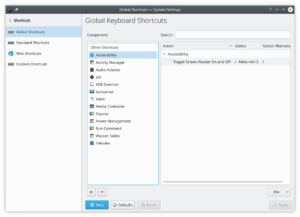System Settings/Atajos de teclado y gestos del ratón
 |
Edita los atajos del teclado y los gestos del ratón para el sistema |

Accesos rápidos personalizados
Aquí se edita la configuración para las acciones de entrada, incluyendo los gestos del ratón.

Accesos rápidos de teclado estándar
Aquí se pueden configurar los atajos de teclado para algunas acciones comunes a muchas aplicaciones. Entre ellas se incluyen Abrir, Guardar, Cerrar, Cortar, Copiar, Pegar, Buscar, y muchas más.

Accesos rápidos de teclado globales
Los accesos rápidos de teclado globales se usan con aplicaciones que no muestran ninguna interfaz. Las opciones para este tipo de accesos rápidos se editan aquí.
Gestos del ratón
El lugar por donde empezar es (en KDE SC 4.5 es en )
Activar los gestos de ratón
En la esquina inferior izquierda de la pantalla hay un botón . Asegúrate de que la casilla está activada. Establece el tiempo de espera que mejor te parezca. Tu botón derecho del ratón puede ser diferente, yo he elegido 3 para usar el botón derecho del ratón. Si quieres que los gestos de ratón se activen automáticamente, activa la casilla "Inicia el demonio de entradas en el inicio de sesión".
Crear un grupo de acciones de gestos de ratón
Right click on the left pane (in an empty area under the list of action groups) and choose , rename that group to "Mouse Gestures" and check the checkbox attached to its name.
Creating a new mouse gesture
From now on I will assume that the new group is called "Mouse Gestures". Right click on and choose (here there are three options but I didn't manage to work with "Send Keyboard Input") using "Command/URL" or "D-Bus Command" you will need to create a gesture and bind an action to it.
To create the gesture
Click on your and select the tab. in the bottom of the screen there is an button (click it). In the box that just opened draw your gesture using the left mouse button.
To bind an action
if you chose simply enter that command/url under the tab at the field.
Examples using Command/URL
Close window
This command will let you close the next window you mouse click on.
Command/URL: wmctrl -c :SELECT:
to close the active window
Command/URL: wmctrl -c :ACTIVE:
Translate clipboard content
This command will display a translation of the current clipboard content.
- Required for this are:
- xclip
- libtranslate
Command/URL: kdialog --title "Translation" --msgbox "`xclip -o | translate -f en -t he -`"
Replace 'en' and 'he' with the desired source and destination language, if you are not sure, a full list of language codes is available from the ISO 639-2 list.
Examples using D-Bus
If you chose D-Bus, here are few examples.
Finding out what to fill where, is done with the help of the "Launch D-Bus Browser", using that browser you can find what method you wish to call in what application object. Using D-Bus we need to fill some fields, the field name will be regular and the content italic.
Runner
This will display the Runner dialog.
Remote Application: org.kde.krunner
Remote Object: /App
Function: org.kde.krunner.App.display
Audacious next/previous/pause/play/stop/repeat track
Remote Application: org.mpris.audacious
Remote Object: /Player
Function: org.freedesktop.MediaPlayer.Next (replace Next with Prev/Pause/Stop/Play/Repeat)
Audacious PlayPause track
If not playing will play, if playing will pause.
Remote Application: org.mpris.audacious
Remote Object: /org/atheme/audacious
Function: org.atheme.audacious.PlayPause
display the actions pop-up. (I am using that to search and translate words)
Remote Application: org.kde.klipper
Remote Object: /klipper
Function: org.kde.klipper.klipper.showKlipperManuallyInvokeActionMenu


